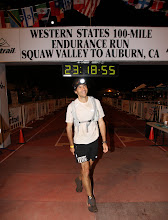Maintaining the levels of sodium, potassium, glucose, and hydration constant throughout a race goes a long way towards a successful run. The body will give you hints, through symptoms, when these are out of balance. Cramping probably means low sodium; lack of saliva points to dehydration; fatigue might mean low glucose, etc. The problem with going by symptoms is that by the time these are manifested your system is already out of balance. Unfortunately, absent a blood test, it’s almost impossible to know exactly what’s going on inside your body. And while it may sound a little extreme, doing my blood work before and after each race is exactly what I am doing now to fine tune my system.
I’ve bought myself an iStat Blood Analyzer. By placing only three or four drops of blood on a disposable cartridge, the iStat will evaluate blood chemistry within a couple of minutes. Disposable cartridges are available for all kinds of test. The cartridges I have purchased analyze the blood for sodium, potassium, glucose, and hematocrit. By comparing these levels immediately before and after each race and knowing exactly what my intakes are during the run, I am discovering what are the right amounts of sodium, potassium, sugar, and water to ingest.
The level of hydration can be determined by body weight. Many ultras will weigh the runners at aid stations to make sure they have not lost or, worse, gained too much weight. But changes in hematocrit can also give you a good sense of hydration. Hematocrit is the percentage of the plasma occupied by red blood cells. If the hematocrit level rises during a race, it means that you have less plasma (i.e. you are not going to produce more blood cells during a race) which points to dehydration. If the hematocrit level decreases, you are probably over hydrated (probably as a result of the body holding back water from lack of sodium).
During the last four races, I have been analyzing my blood immediately before and after every race and recording the exact amounts of sodium, potassium, carbohydrates, and water ingested during the race. With this information, I’ve been fine tuning my intake on subsequent races with the goal of finishing each race with the same levels I had at the start. I’m not quite there, but I’m sure I’ll be able to fine tune it within the next few races.
September 09
Three hard weeks and one recovery week.
2 hours per day, 4 days per week during the hard training weeks with weekends consisting of:
(1) Back-to-back, 3 1/2 hour runs on first weekend.
(2) 9 hour, 11 minute, 50 mile North Face Endurance Run in Washington DC. Placed 29th out of 212.
(3) 5 hour, 32 minute Vermont 50k Race in Ascutney on Sunday followed by 1 1/2 hours on Monday . Placed 24th out of 153 and 3rd in my age category. Picture
2 hours per day, 4 days per week during the hard training weeks with weekends consisting of:
(1) Back-to-back, 3 1/2 hour runs on first weekend.
(2) 9 hour, 11 minute, 50 mile North Face Endurance Run in Washington DC. Placed 29th out of 212.
(3) 5 hour, 32 minute Vermont 50k Race in Ascutney on Sunday followed by 1 1/2 hours on Monday . Placed 24th out of 153 and 3rd in my age category. Picture
Subscribe to:
Comments (Atom)

